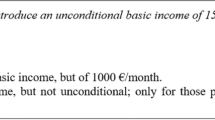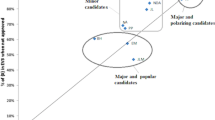Abstract
Are the voter preferences clearly heard in a plurality voting system? Alternate voting schemes wherein the voters rank their choices instead of just voting for their first preference certainly capture the voter preferences in a richer format, but they do not explicitly capture the negative preferences. Here we propose a voting scheme that blends negative voting within a cumulative voting system. In this scheme, we can simultaneously decipher the popularity as well as the polarity of each candidate contesting in the election, giving us a two dimensional view of the candidates. An incentive structure can be built into voting system whereby we can penalize the candidates for their polarity and discourage polarizing campaign rhetorics. Theoretically, this could help depolarize the heated political environment and level the playing field for third party candidates.




Similar content being viewed by others
Notes
The spoiler effect and the Duverger’s law are in some sense flip sides of the same coin. The voter’s behavior to actively avoid a weak candidate (in line with the Duverger’s law) can be viewed as an attempt to minimize the spoiler effect due to that weak candidate.
As a modification, we could remove the \( n^i_{\mu } n^i_{\nu } \) term in both numerator and denominator of Eq. (2) so that the positive correlations between negative votes do not contribute to the compatibility index.
Note that the positive votes cast to the losers have essentially failed to deliver the voter’s wish, and they don’t enter the definition of voter satisfaction. They can be regarded as a measure of unattained-satisfaction, but not explicitly as dissatisfaction. One might find it relevant to subtract them from the voter satisfaction to define \({\bar{S}}_{\alpha } = S_{\alpha } - \sum _{\mu }^{ \mu \ne \alpha } P_{\mu } \). It turns out that maximizing \({\bar{S}}_{\alpha }\) is equivalent to employing \(W_{0}^{1}\) as the evaluation metric.
If the top two apparently strong candidates are genuinely non-polarizing (they wouldn’t have haters) then one of them deserves to win.
References
Arrow KJ (1950) A difficulty in the concept of social welfare. J Polit Econ 58(4):328–346
Balinski M, Laraki R (2007) A theory of measuring, electing, and ranking. Proc Natl Acad Sci 104(21):8720–8725
Black D (1948) On the rationale of group decision-making. J Polit Econ 56(1):23–34
Brams SJ (1977) When is it advantageous to cast a negative vote? Mathematical economics and game theory. Springer, Berlin, pp 564–572
Brams SJ, Fishburn PC (2007) Approval voting. Springer Science and Business Media, Berlin
Cooper DA (2007) The potential of cumulative voting to yield fair representation. J Theor Polit 19(3):277–295
Cox GW (1997) Making votes count: strategic coordination in the world’s electoral systems. Cambridge University Press, Cambridge
de Borda J-C (1784) Mémoire sur les élections au scrutin. Histoire de l’Academie Royale des Sciences pour 1781 (Paris, 1784)
de Condorcet M (1785) Essay on the application of analysis to the probability of majority decisions. Paris: Imprimerie Royale
Duverger M (1959) Political parties: their organization and activity in the modern state. Metheun and Co. Ltd.,
Felsenthal DS (1989) On combining approval with disapproval voting. Behav Sci 34(1):53–60
Felsenthal DS, Machover M (2008) The majority judgement voting procedure: a critical evaluation. Homo Oecon 25(3/4):319–334
Fishburn PC (1977) Condorcet social choice functions. SIAM J Appl Math 33(3):469–489
Gibbard A (1973) Manipulation of voting schemes: a general result. Econ J Econ Soc 41(4):587–601
Green-Armytage J, Tideman TN, Cosman R (2016) Statistical evaluation of voting rules. Soc Choice Welfare 46(1):183–212
Lepelley D, Valognes F (2003) Voting rules, manipulability and social homogeneity. Public Choice 116(1):165–184
List C, Luskin RC, Fishkin JS, McLean I (2013) Deliberation, single-peakedness, and the possibility of meaningful democracy: evidence from deliberative polls. J Polit 75(1):80–95
Myerson RB (2002) Comparison of scoring rules in poisson voting games. J Econ Theory 103(1):219–251
Satterthwaite MA (1975) Strategy-proofness and arrow’s conditions: existence and correspondence theorems for voting procedures and social welfare functions. J Econ Theory 10(2):187–217
Woodall DR (1997) Monotonicity of single-seat preferential election rules. Discret Appl Math 77(1):81–98
Author information
Authors and Affiliations
Corresponding author
Ethics declarations
Competing Interests
The author declares no Competing Interests and no Funding sources.
Additional information
Publisher's Note
Springer Nature remains neutral with regard to jurisdictional claims in published maps and institutional affiliations.
Appendix
Appendix
In the simulated elections presented in Table 1 of Sect. 4, individual ballots were not simulated. Instead, the aggregated positive and negative votes \((P_{\mu },N_{\mu })\) for each candidate \(\mu \) were generated from a uniform distribution. Now, we shall explicitly simulate the individual ballots of the voters, namely generate \((p^{i}_{\mu }, n^{i}_{\mu })\) for each voter-i, and then construct net votes \((P_{\mu },N_{\mu })\) from them. This procedure is computationally more elaborate and time consuming, but it would let us compare NNV to ranked voting procedures.
Each simulated m-candidate election will have 100 voters. For each voter-i , the votes for each candidate \(\mu \) is generated as a real number (rather than integer) from a uniform distribution between (-10,+10), and then they are normalized such that their absolute values sum to 10. If the normalized vote for a candidate-\(\mu \) is positive, then it is taken as \(p^{i}_{\mu }\), while if it is negative, it is taken to be \(n^{i}_{\mu }\). The NNV votes are thus generated from a uniform-normed distribution. For each of these NNV ballots, an associated ranked ballot is prepared by arranging the candidates according to decreasing value of their votes in that ballot. It is ensured that no two candidates have the same rank, else that ballot is rejected. Once the 100 ballots are generated, the Instant Runoff method and the Borda method (discussed in Sect. 5) are employed to determine the winner. Further, using the aggregated \((P_{\mu },N_{\mu })\), the candidate who maximizes the voter satisfaction \(S_{\mu }\) (Eq. (10)) can be determined, as well as the winning candidate according to the NNV evaluation metrics \(W_{0}^{1}\) and \(W_{1}^{1}\).
To determine if the winning candidate also maximizes the voter satisfaction, we simulate thousand elections and evaluate the percentage of these elections in which the winning candidate also maximizes the voter satisfaction.
Table 4 shows that both the Instant Runoff (IR) and the Borda methods perform worse than the NNV metrics in picking a winner who maximizes voter satisfaction. This indicates that the process of converting the cardinal NNV ballots into ranked ballots ignores some of the rich voter preference information. This is not simply a consequence of our definition of voter satisfaction by Eq. (10), since we see that the Borda and IR methods don’t align well even with \(W_{0}^{1}\), nor do they align well with each other as m increases. In comparison to IR, the Borda method’s performance is much better and doesn’t deteriorate for larger m.
The above results are dependent on the probability distribution generating the ballots. Note that by aggregating the simulated individual ballots to construct the net votes, the overall variance in the aggregated \((P_{\mu },N_{\mu })\) would be reduced simply due to the law of large numbers. So, the simulations would very rarely produce situations where there are extreme differences in between the net votes of various candidates. On the other hand, directly simulating the net votes \((P_{\mu },N_{\mu })\) from a uniform distribution would produce situations with extreme differences in between the net votes of various candidates. This may potentially be the cause for the difference in the \(W_{0}^{1}\), \(W_{1}^{1}\) percentages observed between Tables 1 and 4.
Out of curiosity, we could tweak the distribution from which the ballots are generated to make it resemble the voter behavior. When there are many candidates, voters would tend to focus on a relatively few candidates and vote nearly zero for the other candidates. This behavior can be formalized into the distribution in the following way. (i) Generate a real number from uniform distribution between (-10,10) for each candidate-\(\mu \). (ii) Cube these numbers by raising them to power 3 so that each of their sign is preserved, while the magnitude of the larger numbers are selectively exaggerated. (iii) Impose the normalization condition on the cubed numbers such that the sum of the absolute values equals 10, and then extract the \(p^{i}_{\mu }\) and \(n^{i}_{\mu }\). We can refer to this procedure as ballot generation from the cube-normed distribution (as opposed to uniform-normed distribution). Table 5 shows the results of the simulations using cube-normed distribution, and we can note that the performance of both Borda and IR methods have worsened in comparison to Table 4.
Rights and permissions
Springer Nature or its licensor holds exclusive rights to this article under a publishing agreement with the author(s) or other rightsholder(s); author self-archiving of the accepted manuscript version of this article is solely governed by the terms of such publishing agreement and applicable law.
About this article
Cite this article
Shankar, K.H. Normed Negative Voting to Depolarize Politics. Group Decis Negot 31, 1097–1120 (2022). https://doi.org/10.1007/s10726-022-09799-6
Accepted:
Published:
Issue Date:
DOI: https://doi.org/10.1007/s10726-022-09799-6




